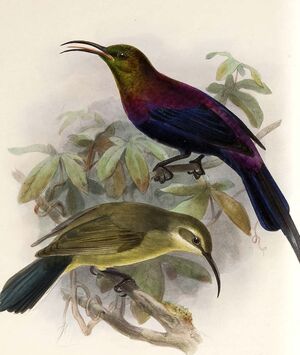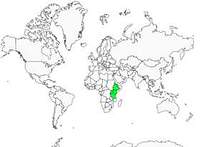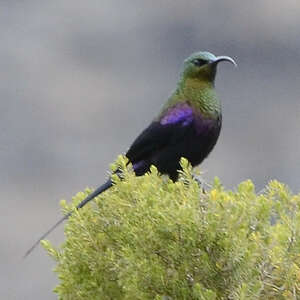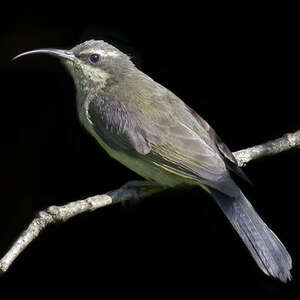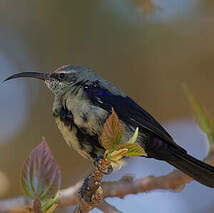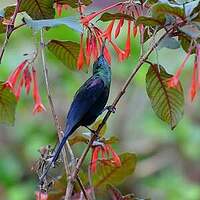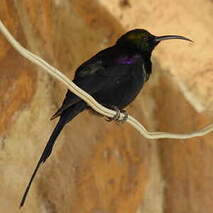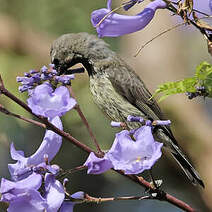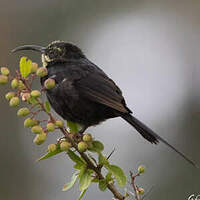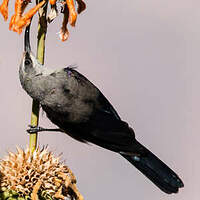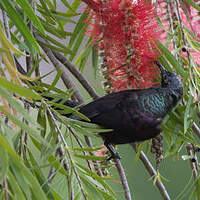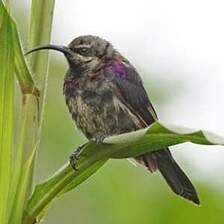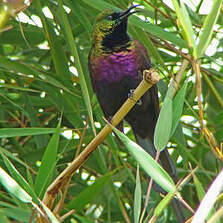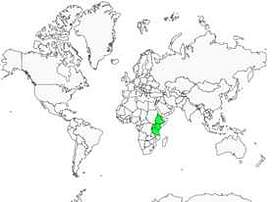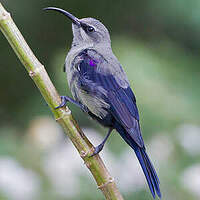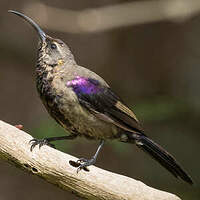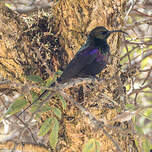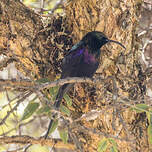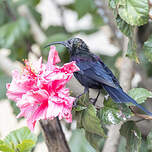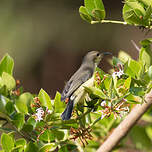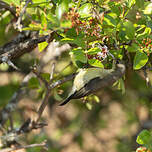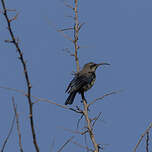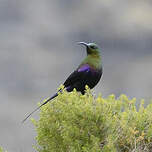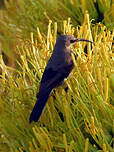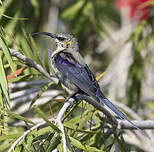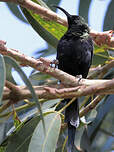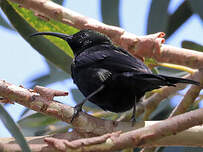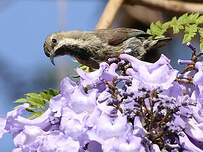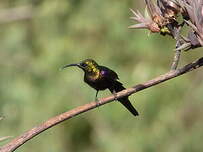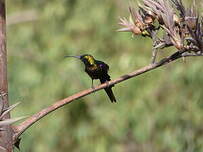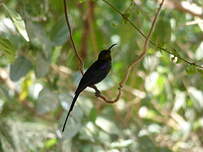Tacazze Sunbird
Nectarinia tacazze - Souimanga tacazze
Identification
The Tacazze Sunbird is the largest of the sunbirds, perhaps in connection with its life at high altitudes. Sexual dimorphism, usual in the family, is evident in this species. The nuptial male appears at a distance as a large, dark sunbird, almost black. Closer up in good light, the front of his body reveals its colours. The head, neck, mantle and upper chest are green with bronze reflections. The coverts and middle of the chest are violet-purple. The rest of the body, wings and tail are black with bluish reflections. The two central rectrices exceed 35-46 mm. The black beak is thin, long and curved. The eyes are dark and the legs are black. The inter-nuptial male looks like the female, but retains its nuptial wings and tail. The female has a rather cold gray-brown upperparts but nuanced with olive, especially on the edges of the remiges. The underparts, pale gray-olive, are clearly tinged with yellow and lightly spotted with dark markings. A blackish band covers the lores and ear and includes a dark eye. It is bordered above by a clear pale eyebrow and a pale malar stripe above. Like the male, legs and beak are black. The stepped tail is dark brown with pale edges and tip. It appears pointed as the central rectrices slightly protrude. The juvenile resembles the female, but with the throat center black and the underside more yellow and more marked.
Subspecific information 2 subspecies
- Nectarinia tacazze tacazze (Ethiopia and Eritrea)
- Nectarinia tacazze jacksoni (se Sudan, Uganda, Kenya and n Tanzania)
Foreign names
- Souimanga tacazze,
- Suimanga de Tacazzé,
- nectarínia-violácea,
- Tacazzenektarvogel,
- Tacazze-nektármadár,
- Tacazzehoningzuiger,
- Nettarinia del Tacazze,
- tekezésolfågel,
- Purpurkappesolfugl,
- nektárovka vrchovská,
- strdimil ostrochvostý,
- Tacazzesolfugl,
- säihkymedestäjä,
- suimanga del riu Tekezé,
- nektarnik złotogłowy,
- Колибриевая нектарница,
- ルビーオナガタイヨウチョウ,
- 塔卡花蜜鸟,
- tekezésolfågel,
- 塔卡茲花蜜鳥,
Voice song and call
The song of the Tacazze Sunbird is a lively, long and varied chirping, made up of elements like sweet-siuswitterr tseu seet-swirursittii and ending with a repeated note tsit-tsit-tsit-chitichitichiti... or tew tew tew tew tew tew. The call is composed of brief notes like chup, chup, chup, seee chup chup, seee chup.
Habitat
The Tacazze Sunbird inhabits open forests and mountain scrub, herbaceous moors and other flower-rich fallow land, as well as the gardens and cultivated lands on the higher plateaus. It can be found above 1,650 metres in altitude in southern Kenya, but is rare below 1,800 metres elsewhere, such as in Ethiopia. It ascends up to 4,000 metres on Mount Kenya and even 4,200 metres on Mount Elgon in Uganda.
Behaviour character trait
The Tacazze Sunbird is a vocal bird. To protect its territory or a food source, it can be quite aggressive towards its peers and particularly towards Malachite Sunbirds in regions where the two species coexist.
Highly territorial, it remains faithful to its site. One male has stayed on the same territory for 6 years without interruption, another for 8. It usually lives in isolation or in pairs. Apart from the breeding season, large gatherings form around nectar sources. It is not a migratory species. Its only substantial movements are altitude movements depending on the season, on the slopes of Mount Elgon for example. Non-reproducing males prefer to go to the lower slopes of the mountain during the cool and wet season from June to August. Outside of that period they reside at altitude. In December it is widely visible around 2800 metres while it will be totally absent in July. In South Sudan, it leaves the high mountains as soon as the giant Lobelias have finished flowering. In order to withstand the cold night that prevails at altitude, the Tacazze Sunbird has the ability to temporarily enter hypothermia, its body temperature being able to drop to 27 °C.Flight
Dietfeeding habits
The Tacazze Sunbird feeds on nectar from flowers, with a particular preference for the flowers of Giant Lobelia and Kniphofia.
It also likes aloes, Loranthaceae, Leonotis mollissima, Protea, and flowering lianas such as Impatiens elegantissima and Kigelia africana. Some insects and spiders gathered directly from the flowers or caught in flight form part of its diet. It is quite easy for it to, for example, catch flying ants in flight. Finally, it does not hesitate to take advantage of the sweet water made available to sunbirds in gardens.Reproduction nesting
During the breeding season, male Tacazze Sunbirds show high levels of aggression, not only with other males but also with other Tacazze Sunbirds.
The female builds a pear-shaped nest in 3 to 8 days, which is around 20 cm long and 10 cm wide. She attaches the nest to a fixture, usually a branch, but also a rock or other, at a height of 1.5 to 10 meters. The nest is composed of dead leaves, grass, twigs, bark, feathers and animal hair, all held together with spider silk. There is a small entrance measuring 2.5 cm at the top of the nest. Inside, the female lines the nest with soft down. The chamber is quite small, despite the size of the nest, and its thick walls serve as insulation against lower temperatures. The male does not take part in the construction of the nest but remains close to the female. She incubates alone for 14 to 17 days. The eggs, one or two, are a blue-green colour with dark brown and pale pink speckles. Both sexes take part in the feeding of the young, but only the female removes the fecal sacks from the nest. The chicks leave the nest at the age of 19 days but return for the first six nights after the fledge. The nest can be parasitized by the Common Cuckoo or the nest predated by the Issfischer's Warbler.Geographic range
The species is only found in the northeast of Africa. The subspecies Tacazze is found on the high plateaus of Eritrea and Ethiopia, while the ssp jacksoni lives in the highlands of southern Sudan, from northern Tanzania to northern Uganda, through the northwest and western Uganda and western and central Kenya.
Threats - protection
Sources of information
- IOC World Bird List (v14.2), Gill, F and D Donsker (Eds). 2024-04-18.
- Sunbirds, Roberts A. Cheke, Clive F. Mann and Richard Allen
- Birds of East Africa, C.A.W. Guggisberg
- HBW Alive,
Other sources of interest
 Specification sheet created on
21/07/2023 by Nathalie Santa Maria
Specification sheet created on
21/07/2023 by Nathalie Santa MariaTranslation by AI Oiseaux.net
© 1996-2025 Oiseaux.net
- Accipitriformes
- Aegotheliformes
- Anseriformes
- Apodiformes
- Apterygiformes
- Bucerotiformes
- Caprimulgiformes
- Cariamiformes
- Casuariiformes
- Charadriiformes
- Ciconiiformes
- Coliiformes
- Columbiformes
- Coraciiformes
- Cuculiformes
- Eurypygiformes
- Falconiformes
- Galliformes
- Gaviiformes
- Gruiformes
- Leptosomiformes
- Mesitornithiformes
- Musophagiformes
- Nyctibiiformes
- Opisthocomiformes
- Otidiformes
- Passeriformes
- Pelecaniformes
- Phaethontiformes
- Phoenicopteriformes
- Piciformes
- Podargiformes
- Podicipediformes
- Procellariiformes
- Psittaciformes
- Pterocliformes
- Rheiformes
- Sphenisciformes
- Steatornithiformes
- Strigiformes
- Struthioniformes
- Suliformes
- Tinamiformes
- Trogoniformes

